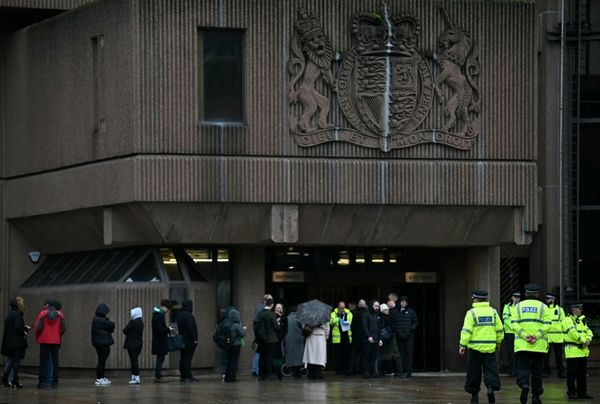Few animals are as recognisable as the crab: a rounded, flat body covered in a hard shell, attached to scuttling legs and a pair of pincers.
But not everything that looks like a crab is, technically, a true crab.
Crustaceans have evolved a crab-like body at least five times, resulting in thousands of species of "false crabs".
The process of very distantly related organisms independently developing the same characteristics is known as convergent evolution.
For instance, thylacines had a body that looked very much like that of a dog, but their last common ancestor trotted around 160 million years ago.
"The assumption is that if some creatures look similar, they must be related," said Kareen Schnabel, a marine biologist at New Zealand's National Institute of Water and Atmospheric Research who studies false crabs.
"But that just doesn't work for … these more advanced crustaceans."
For crabs, the process is dubbed "carcinisation", a term coined more than a century ago.
So why do crab-like creatures keep turning up on the evolutionary tree, and what makes a true crab truly a crab?
We'll give you some crab-spotting tips, but first, let's wind the clock back a couple hundred million years to the ancestral crab.
When crabs branched out
The last common ancestor of true crabs and their false counterparts lived around 250 million years ago, and may have looked more like a lobster than a typical crab, said Rachael Peart, who also studies crustaceans at New Zealand's National Institute of Water and Atmospheric Research.
Back then, the lineage split into two main groups: one called Brachyura, which are considered true crabs, and Anomura, or what biologists consider false crabs.
But it wasn't until between 145 and 66 million years ago that both groups really stepped up their diversification game, splitting into thousands of new species.
Some researchers suspect the trigger for this "Cretaceous crab revolution" was a concurrent explosion in reef-building coral species.
Assigning current-day "crabs" to true and false groups has not been without its problems, but advances in genetics have helped re-categorise some into their rightful group.
"The king crabs used to be considered true crabs, but they're not," Dr Peart said.
"They're actually closest related to hermit crabs."
How to spot a true crab
You're at the beach, and you spot a crab-looking crustacean waving its claws and scuttling around on the sand. How do you know if it's a true crab or a false one?
1. Look at its legs
Specifically, count the pairs of limbs it uses to get around, also called "walking legs".
True crabs have four pairs of walking legs, while false crabs often have three pairs.
Their fourth pair of legs is still there, but are too short to help them walk.
2. Analyse the antennae
Does the creature have antenna between its eyes and nowhere else? If so, that's another sign of a true crab.
False crabs can have antenna either side of their eyes.
3. Check out its carapace
The hard "lid" covering a true crab's head and upper body — called its carapace — is broad and flat, and typically wider than it is long, Dr Peart said.
"Your blue swimmer crab has a really typical true crab shape."
A true crab's carapace is also completely fused, like a plate. Some false crabs have a carapace that's still somewhat segmented, and looks a bit like path pavers.
"The yeti crabs, which are found in the Australian Southern Ocean, are really quite spectacular and some of them look like true crabs," Dr Peart said.
"But you can see on their carapace there are 'sutures' there, and it's not fused."
4. Take a peek at its tail
If you get to see the crustacean's underside, check out its abdomen, which we tend to think of as its tail.
True crabs flatten and completely tuck their tail under their carapace.
But if you see a fan on the end of the tail, that's a false crab. True crab tails are fan-free.
Why do crab-like features keep appearing?
Exactly why crustaceans keep "crabifying" isn't entirely settled.
But some crab qualities have clear benefits. For instance, being flatter lowers an animal's centre of gravity, allowing it to scuttle away faster.
A teeny, tucked-away tail might mean a crustacean can no longer flick it quickly to escape predators, but losing that meaty bulk has an upside, Dr Schnabel said.
"If you can reduce that all down, you can, for example, tuck into smaller crevices in corals or amongst rock."
So is "crabification" inevitable? Are all crustaceans destined to end up looking like crabs?
Nope.
Some true crabs — and even some crab-like false ones — have already evolved to look less like crabs.
For instance, there are true crabs that like to burrow in mud, and they're evolving a longer, more lobster-like body that's more suited to their surroundings, Dr Schnabel said.
"If you're barrel-shaped, you can better retreat into soft sediment and evade predators or be more stealthy."
This "decarcinisation", according to a study published by a trio of US researchers last year, has happened at least seven times.
"Therefore," they write, "the crab-like body plan cannot represent an optimum for all niches, and may be subject to functional trade-offs that allow the evolution (and sometimes persistence) of decarcinisation."







